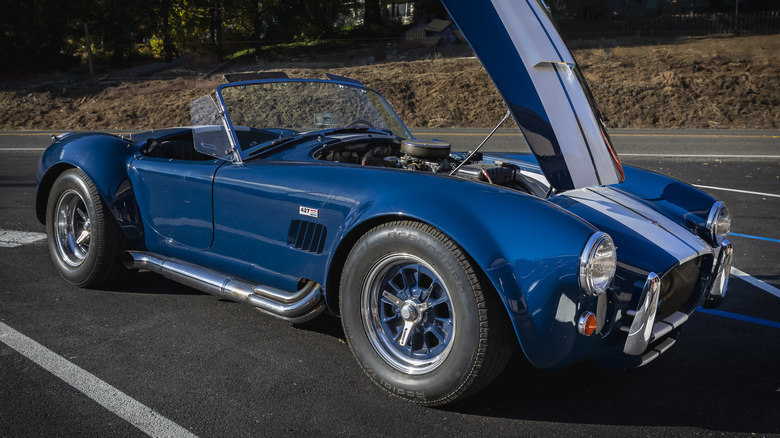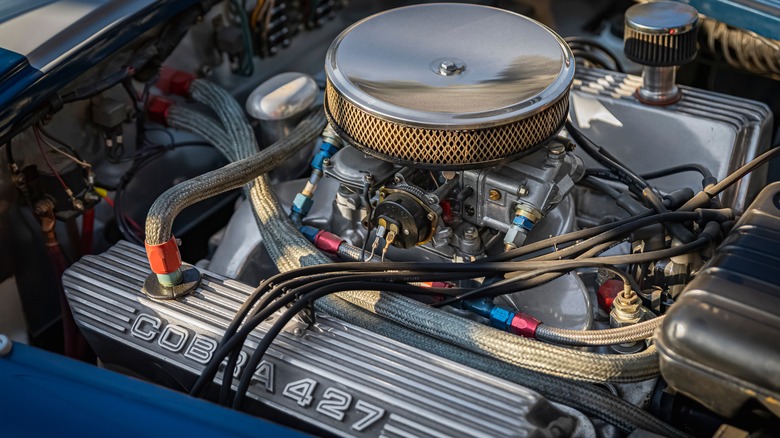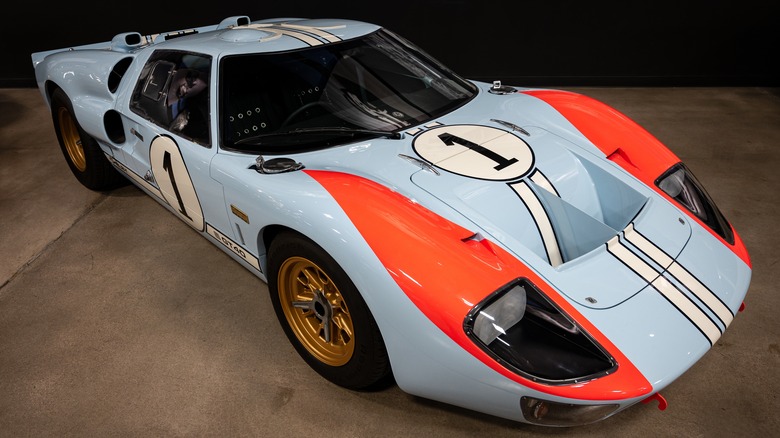How Ford's 427 Big Block Took Racing By Storm
In 1958, Ford introduced its new FE series of V8 engines (short for Ford-Edsel) to replace the short-lived Y-block — itself a replacement for the truly antiquated flathead V8s. The FE was a tremendous success by any measure, powering everything from farm equipment to pickup trucks to fire-breathing Shelby Mustangs until its discontinuation in 1976.
Perhaps the most famous version of the FE engine is Ford's 427 cubic inch (7.0 liter) big-block, which propelled its GT40 race car to beat Ferrari with first place finishes at 24 Hours of Le Mans in 1966 and 1967 — before a rules change limited engine displacement to a maximum of 5.0 liters.
Although heavily based on the same 427 cubic inch engine that was available in a regular Ford Galaxie, the race engines were put on a diet with an aluminum intake manifold, aluminum cylinder heads, and a magnesium oil pan. All told, the lightweight bits shaved approximately 130 pounds from the street 427.
In production cars, the pushrod 427 developed approximately 410-425 horsepower depending on the number of carburetors, but in race tune, it was easy to squeeze an additional 100 horsepower from the 7.0 liter V8. In preparing for Le Mans, Ford briefly considered running a recently developed and exotic overhead cam version of the 427 V8, but it was ultimately deemed too heavy and unwieldy for the compact GT40 road racers.
An overhead cam version was outlawed by NASCAR
If the overhead cam variation of the 427 was too bulky for the slinky GT40, then it was just perfect for the large engine bays of NASCAR stock cars, as well as exposed drag racing applications. Although overhead camshafts — camshafts contained within the engine's cylinder heads — dominate modern engine design, it was cutting edge technology in the mid-1960s, especially from a domestic automaker.
The overhead cam (nicknamed the "Cammer") 427's participation in NASCAR racing was met with extreme resistance. In 1964, NASCAR head honcho Bill France turned down Ford's request to compete with the new motor. Since Ford desperately needed a method to stay competitive against Chrysler's new 426 cubic inch engine with hemispherical combustion chambers (the Hemi), it forged on with developing the Cammer anyway.
Later that year, NASCAR banned all "special racing engines," which included not only Ford's Cammer, but also the Chrysler Hemi. In retaliation, Chrysler actually withdrew from NASCAR racing for a period of time, but Ford was more accepting of the edict and continued to race with its conventional pushrod version of the 427. This was the same engine type that powered many examples of the GT40 and Shelby Cobras of the era.
Ford eventually withdrew racing support altogether
Spurned from stock car racing, Ford focused the overhead cam 427 on quarter-mile drag racing. Stuffed into top fuel dragsters and the newly emerging funny cars — which approximated the appearance of regular production vehicles — the "Cammer" was fed nitromethane fuel instead of gasoline, and forced induction was added in the form of a giant supercharger.
With these modifications, the overhead cam 427 could produce as much as 2,500 horsepower, but its Achilles heel was the seven-feet-long timing chain that snaked across the front of the engine to drive the camshafts mounted high in the cylinder heads. With the help of aftermarket suppliers such as Crane Cams, drag racers developed a more durable gear-drive system to replace the timing chain.
In the later half of the 1960s, Ford started to withdraw funding and support for the 427 Cammer in drag racing, marking the end of an interesting era. Some drivers, such as Connie Kalitta and "Sneaky Pete" Robinson, saw potential in the engine. The two campaigned for these engines into the early 1970s without official backing, but eventually, just about all top fuel and funny car drivers adopted Chrysler's Hemi as the mill of choice.
Whether it was the pushrod version for NASCAR and road racing, or the exotic overhead cam drag racing powerplant, the competitiveness of Ford's 427 cubic inch big block in the mid to late 1960s cannot be overstated, fulfilling Ford's long-time mantra of "Win On Sunday, Sell On Monday."


